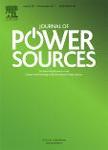版权所有:内蒙古大学图书馆 技术提供:维普资讯• 智图
内蒙古自治区呼和浩特市赛罕区大学西街235号 邮编: 010021

作者机构:Univ Elect Sci & Technol China Sch Automat Engn Chengdu 610054 Peoples R China Tsinghua Univ Sch Vehicle & Mobil State Key Lab Automot Safety & Energy Beijing 100084 Peoples R China Huazhong Univ Sci & Technol Sch Artificial Intelligence & Automat Key Lab Image Proc & Intelligent Control Educ Min Wuhan 430074 Peoples R China
出 版 物:《JOURNAL OF POWER SOURCES》 (电源杂志)
年 卷 期:2020年第480卷
页 面:229102-229102页
核心收录:
学科分类:0820[工学-石油与天然气工程] 08[工学] 0807[工学-动力工程及工程热物理] 0805[工学-材料科学与工程(可授工学、理学学位)] 0703[理学-化学]
基 金:State Key Laboratory of Automotive Safety and Energy [KF2022] Department of Science and Technology of Sichuan Province [2020YJ0109] Fundamental Research Funds for the Central Universities [ZYGX2019J060] National Natural Science Foundation of China [61304114, 61573162, 61873323]
主 题:Solid oxide fuel cell (SOFC) Discharge performance recovery Prognostic Iterative learning control
摘 要:Before the commercialization of solid oxide fuel cells, degradation is considered one of the biggest technical problems, which may lead to a decrease in the discharge performance of the fuel cell. This paper proposes a prognostic-based control strategy to restore the discharge performance during the degradation process, thereby extending the life of the fuel cell. A prognostic approach based on wavelet decomposition and an echo state network is utilized to predict the downward trend in the discharge performance, and then iterative learning controllers are designed to restore the discharge performance. Taking nickel coarsening and oxidation degradation mechanisms as an example, several controllers with different discharge performance recovery capabilities are built. The simulation results show that compared with no controller, the power generation efficiency using the proposed strategy is reduced by 12.4% at most, while the remaining useful lifetime is increased by at least 26.3%. The proposed strategy can restore the discharge performance without significant reduction in the generation efficiency. The proposed method is not only suitable for nickel coarsening and oxidation degradation, but also can be generalized to different types of degradation and different types of fuel cells.